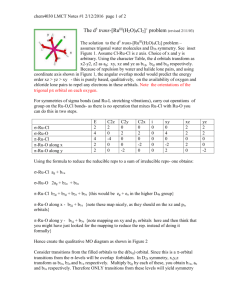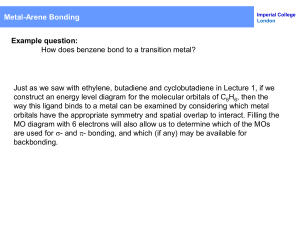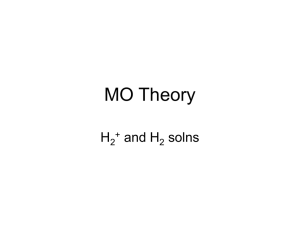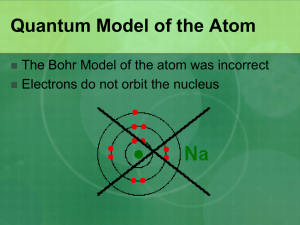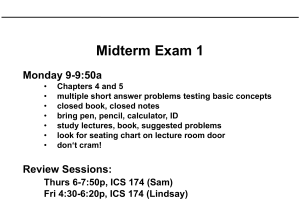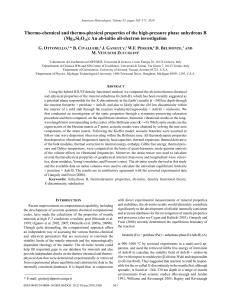Document
advertisement
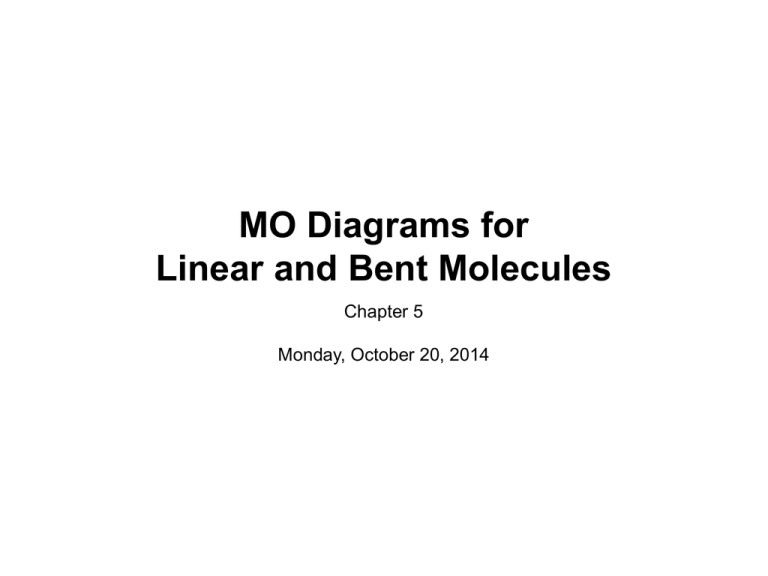
MO Diagrams for Linear and Bent Molecules Chapter 5 Monday, October 20, 2014 Molecular Orbitals for Larger Molecules 1. Determine point group of molecule (if linear, use D2h and C2v instead of D∞h or C∞v) 2. Assign x, y, z coordinates (z axis is principal axis; if non-linear, y axes of outer atoms point to central atom) 3. Find the characters of the reducible representation for the combination of valence orbitals on the outer atoms. Treat s, px , py , pz etc separately (as for vibrations, orbitals that change position = 0, orbitals that do not change =1; and orbitals that remain in the same position but change sign = -1) 4. Find the irreducible representations (they correspond to the symmetry of group orbitals, also called Symmetry Adapted Linear Combinations SALCs of the orbitals) 5. Find AOs on central atom with the same symmetry 6. Combine AOs from central atom with those group orbitals of same symmetry and similar energy to make the MO diagram Linear H3+ by Inspection Among the easiest multi-atom molecules to build is linear H3+. General procedure for simple molecules that contain a central atom: build group orbitals using the outer atoms, then interact the group orbitals with the central atom orbitals to make the MOs. + H · H H–H–H + group of outer atoms group orbitals u H+ central atom g g Only group orbitals and central atom orbitals with the same symmetry and similar energy will interact. Linear H3+ g orbitals interact, while u orbital is nonbonding. g σ* u u g nb g g σ H+ 3-center, 2-electron bond! + H–H–H H · H Linear FHF- by Inspection In building the group orbitals for FHF-, we must consider the 2s and 2p orbitals of the two fluorines (8 AOs in total). Use point group D2h. - F–H–F F · F + group of outer atoms Hcentral atom Ag group orbitals 2px B3u B2g 2py B2u B3g 2pz Ag B1u 2s Ag B1u Linear FHFIn building the group orbitals for FHF-, we must consider the 2s and 2p orbitals of the two fluorines (8 AOs in total). Use point group D2h. - F–H–F F · F + group of outer atoms Hcentral atom Ag group orbitals 2px B3u B2g 2py B2u B3g 2pz Ag B1u 2s Ag B1u Linear FHFIn building the group orbitals for FHF-, we must consider the 2s and 2p orbitals of the two fluorines (8 AOs in total). Use point group D2h. - F–H–F F · F + group of outer atoms Hcentral atom Ag 2px group orbitals B3u B2g 2py B2u B3g 2pz Ag B1u 2s Ag B1u The central atom has proper symmetry to interact only with group orbitals 1 and 3. Relative AO Energies for MO Diagrams F 2s orbital is very deep in energy and will be essentially nonbonding. B Li H Al Na C N –13.6 eV 2p Al O F 1s C P Mg Be B Si –18.6 eV Ne 2s He Si S 3p 3s Cl P S N Cl Ar O F –40.2 eV Ne Ar Linear FHFF 2s orbitals are too deep in energy to interact, leaving an interaction (σ) only with group orbital 3. Some sp mixing occurs between ag and b1u MOs. The two fluorines are too far apart to interact directly (S very small). nonbonding nb very weak bond : : bond : : Lewis: :F:H:F: MO: >1 bonds, >6 lone pairs Carbon Dioxide by Inspection CO2 is also linear. Here all three atoms have 2s and 2p orbitals to consider. Again, use point group D2h instead of D∞h. O=C=O O · O group of outer atoms group orbitals same as F- -F 2px B3u B2g 2py B2u B3g 2pz Ag B1u 2s Ag B1u + C central atom Ag B1u B3u B2u carbon has four AOs to consider! Relative AO Energies in MO Diagrams Use AO energies to draw MO diagram to scale (more or less). Al B Li C –10.7 eV Be H –19.4 eV 2p C O Si P Mg N B 1s Na –15.8 eV F Si Ne 2s He Al S 3p 3s Cl P S N Cl Ar –32.4 eV O F Ne Ar Carbon Dioxide 4b1u –10.7 eV 4ag B2u B3u B1u B2g B1u B3g –15.8 eV B2u 3b1u –19.4 eV Ag Ag B3u 3ag B1u 2b1u C 2ag O=C=O –32.4 eV Ag O·O Carbon Dioxide 4b1u 2b2u 2b3u –10.7 eV 4ag B2u B3u B1u 1b2g 1b3g B2g B1u B3g –15.8 eV 1b2u 1b3u 3b1u –19.4 eV Ag B2u Ag B3u 3ag B1u 2b1u C 2ag O=C=O –32.4 eV Ag O·O Carbon Dioxide –10.7 eV –15.8 eV two π bonds –19.4 eV two σ bonds –32.4 eV four lone pairs centered on oxygen C O=C=O O·O Molecular Orbitals for Larger Molecules To this point we’ve built the group orbitals by inspection. For more complicated molecules, it is better to use the procedure given earlier: 1. Determine point group of molecule (if linear, use D2h and C2v instead of D∞h or C∞v) 2. Assign x, y, z coordinates (z axis is principal axis; if non-linear, y axes of outer atoms point to central atom) 3. Find the characters of the reducible representation for the combination of valence orbitals on the outer atoms. Treat s, px , py , pz etc separately (as for vibrations, orbitals that change position = 0, orbitals that do not change =1; and orbitals that remain in the same position but change sign = -1) 4. Find the irreducible representations (they correspond to the symmetry of group orbitals, also called Symmetry Adapted Linear Combinations SALCs of the orbitals) 5. Find AOs on central atom with the same symmetry 6. Combine AOs from central atom with those group orbitals of same symmetry and similar energy Carbon Dioxide by Reducible Representations 1. Use point group D2h instead of D∞h (this is called descending in symmetry). 2. 3. Make reducible reps for outer atoms 4. Get group orbital symmetries by reducing each Γ Γ2s 2 2 0 0 0 0 2 2 Γ2pz 2 2 0 0 0 0 2 2 Γ2px 2 -2 0 0 0 0 2 -2 Γ2py 2 -2 0 0 0 0 -2 2 Γ2s = Ag + B1u Γ2pz = Ag + B1u Γ2px = B2g + B3u Γ2py = B3g + B2u Carbon Dioxide by Reducible Representations Γ2s = Ag + B1u Γ2pz = Ag + B1u Γ2px = B2g + B3u Γ2py = B3g + B2u These are the same group orbital symmetries that we got using inspection. We can (re)draw them. 2px B3u B2g 2py B2u B3g 2pz Ag B1u 2s Ag B1u 5. Find matching orbitals on central atom Ag B1u B3u 6. Build MO diagram… B2u Carbon Dioxide –10.7 eV –15.8 eV –19.4 eV –32.4 eV C O=C=O O·O Water 1. Point group C2v 2. 3. Make reducible reps for outer atoms Γ1s 4. Get group orbital symmetries by reducing Γ 2 0 Γ1s = A1 + B1 2 0 Water Γ1s = A1 + B1 The hydrogen group orbitals look like: A1 B1 5. Find matching orbitals on central O atom A1 A1 B1 B2 6. Build MO diagram. We expect six MOs, with the O 2py totally nonbonding. Water Based on the large ΔE, we expect O 2s to be almost nonbonding. B Li H Al Na C P Mg Be N –13.6 eV B 2p O –15.8 eV F 1s C Si Si Ne 2s He Al S 3p 3s Cl P S N Cl Ar –32.4 eV O F Ne Ar Water With the orbital shapes, symmetries, and energies in hand we can make the MO diagram! 2b 1 B1 A1 4a1 –13.6 eV A1 nb –15.8 eV 1b2 B1 B2 σ 3a1 1b1 σ –32.4 eV A1 nb 2a1 Two bonds, two lone pairs on O. HOMO is nonbonding.
